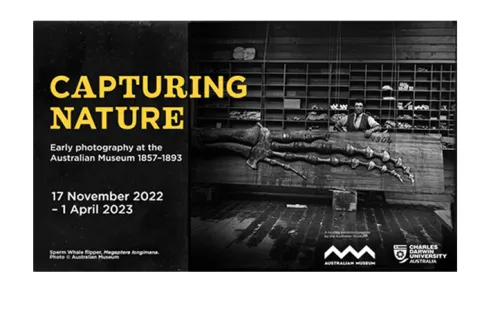Taken from the Australian Museum’s extensive archival collection of glass plate negatives, 67 large-format photographic prints showcase the scientific discoveries of Australian Museum scientists between the 1850s and 1890s, while also telling the story of the advent of photography in the young colony, less than 10 years after the birth of photography in Europe.
The images range from the initial tentative experiments in the 1850s to the time when photography was becoming an indispensable part of museum practice in the early 1890s. The subjects vary from a large sunfish and the flipper of a sperm whale to a gorilla and the fragile bones of a flamingo. Most of the specimens photographed at the museum are by taxidermist, Henry Barnes and his son, Henry Barnes Jnr with the help of the Australian Museum’s pioneering Curator Gerard Krefft.
Australian Museum Director and CEO, Kim McKay AO, said some of the earliest adopters of photography were scientists.
“They were quick to see its enormous potential for capturing the process of discovery and describing new species which are the foundation of scientific practice,” she said.
“In the Victorian era, museums were the public face of science. At the Australian Museum, the arrival of curator and scientist Gerard Krefft in 1864 marked a fortuitous coming together of skills, experience and technology.”
“The images by Gerard Krefft, and his taxidermist, Henry Barnes, not only produced records for the Museum, but also helped them share the Museum's work around the world. Their early images showcase the creativity, innovation and experimentation that were, and remain, part of the Australian Museum's DNA,” McKay added.
In a time before photography scientists relied on illustrators, or their own drawings, to depict their discoveries and research work. The illustrations took time, patience and meticulous skill. But with the advent of photography, the documentation of natural history now provided important evidence of the finds while also contributing to the standing of the Australian Museum scientists, at home and abroad.
The early glass plates are called V-negatives, with the oldest dating back as early as the 1850s, making them some of the earliest scientific photographs taken in Australia. The new technology captured light on glass and provided, for the first time, an unmediated, mechanical representation of nature and the world.
Curator of the exhibition and author of the accompanying book, AM’s Archivist and Manager of Rare Books Vanessa Finney said the AM has over 15,000 glass plate negatives in its photographic archives.
“The photographs document the rapid expansion of the Museum’s specimen collections in the 19th century. They are a museum ‘rogues’ gallery’: dozens of animals captured, mugshot style, against a white-sheet backdrop,” Finney said.
Photography was expensive and complicated, so every photograph was carefully planned. The animals were first prepared and posed and then positioned for best natural light and least shadow. The photos were taken in and around the museum, mostly in the courtyards and gardens to best exploit the precious light required by the photographers’ rudimentary cameras. Alongside the specimens, the figures of scientists can often be seen as a gauge of scale.
“In these days of instant digital images, it’s hard to imagine the effort that went into creating photos during photography’s first century and a half. Each single image was precious -- and painstaking to create.” Finney said.
Finney explained that through their photography, Krefft and Barnes were spreading the knowledge of Australian science.
“Their photographs disseminated to the world the image of Australia and its fauna at a time of great international enthusiasm for the fledgling colony’s unusual plants and animals.”
Beautiful, haunting and sometimes strange, Capturing Nature is not only a unique record of early Australian science but also brings to life the story of one of humankind’s greatest inventions.
